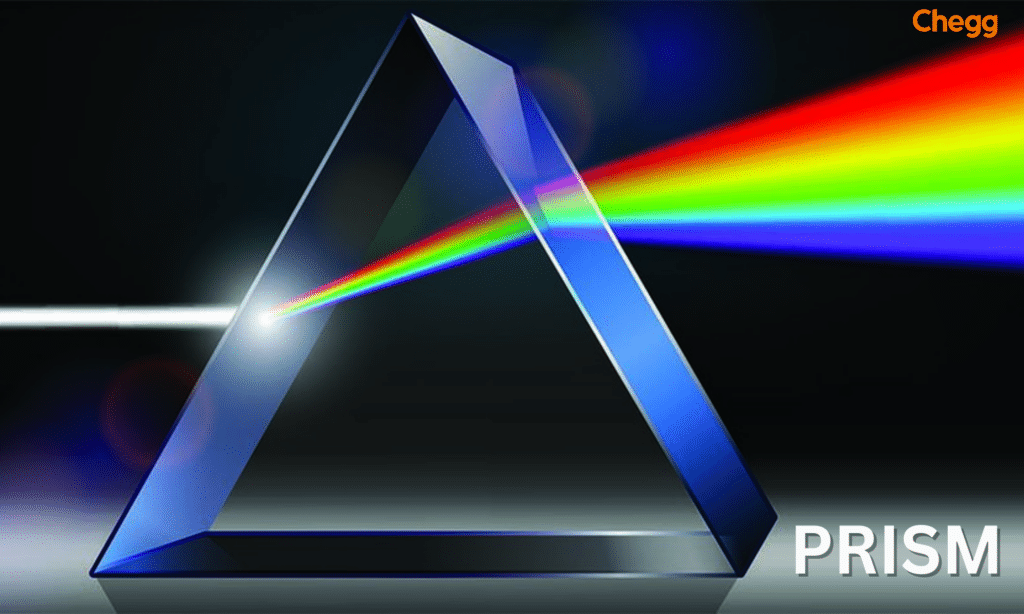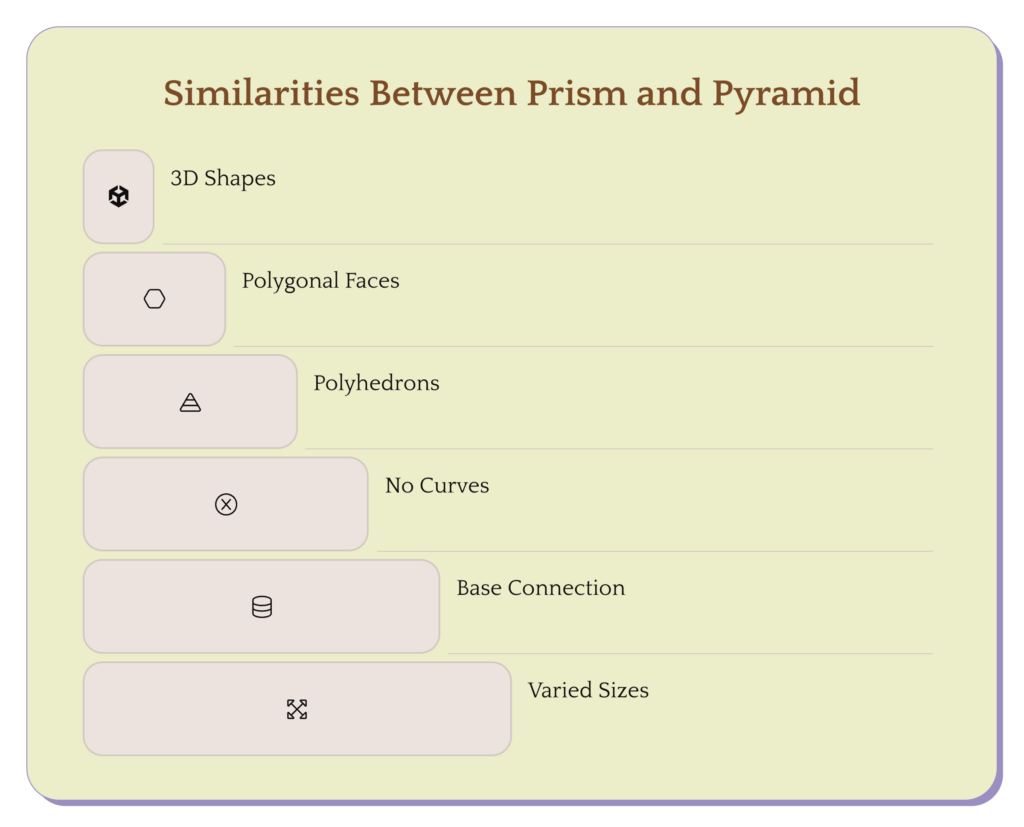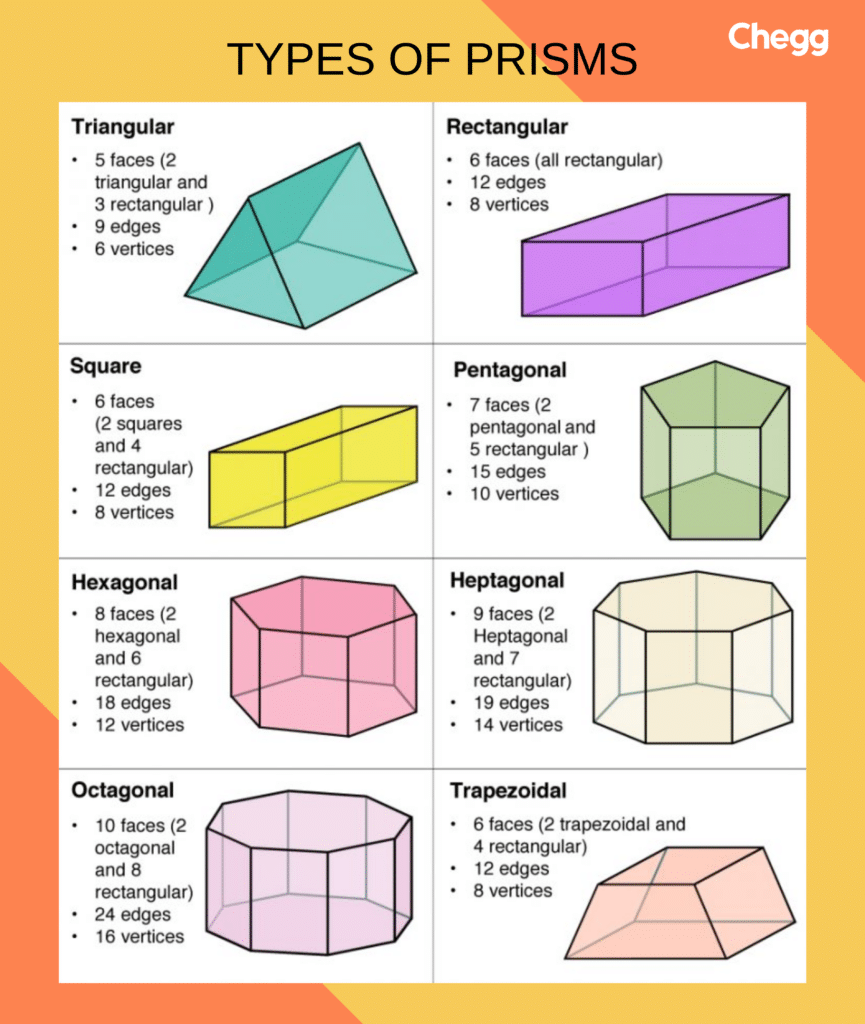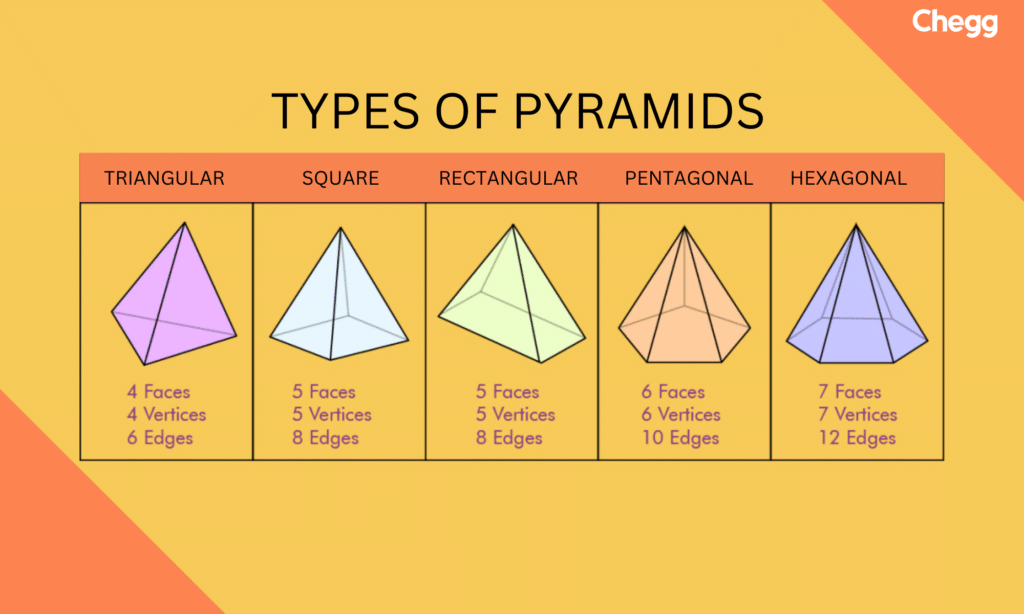
Quick Summary
Table of Contents
A prism and a pyramid are three-dimensional shapes, but they differ in structure. A prism features two identical, parallel bases connected by rectangular faces. In contrast, a pyramid has one base (of any polygonal shape) with triangular faces that converge at a single point known as the apex.
The difference between Prism and Pyramid is that a prism features two identical, parallel bases linked by rectangular or parallelogram-shaped faces. In contrast, a pyramid has a single base with triangular faces converging at a point known as the apex.
A prism is like a 3D shape with two identical bases and flat sides connecting them. These sides are always flat, and the edges are straight, creating a uniform shape. Imagine it as a sandwich with the same filling but in a three-dimensional space. Prisms can have various base shapes, such as triangles or rectangles, and the sides connecting these bases are always perpendicular to the bases. Of course, this unique geometry distinguishes prisms from other 3D shapes.

A pyramid, in contrast, is a unique shape defined by a polygonal base and triangular sides that come together at a single point known as the apex. The base can have various polygonal shapes, but square and triangular bases are the most typical. Think of a pyramid as a building with a pointed roof, like the iconic ancient Egyptian pyramids, which were monumental tombs for pharaohs. This is a key difference between prism and pyramid, as a prism has two parallel identical polygonal bases. In contrast, a pyramid has a single polygonal base with triangular sides converging at the apex.

| Prism | Pyramid |
| A prism has a two-base 3D polyhedron shape. | A pyramid has a single-base 3D polyhedron shape. |
| It has rectangular-shaped sides. | It has triangular-shaped sides. |
| The prism’s sides are perpendicular to the base. | The sides of the pyramid are angled with respect to the base. |
| Prism has no apex to it. | A pyramid has an apex. |
| Its sides may not always come together at one point. | There’s a point at which its sides come together. |
| Prism consists of 2 bases. | Pyramids consist of 1 base. |
| It deals with the fields of geometry and optics. | It deals with the field of geometry only. |
Prisms have versatile applications in everyday life and mathematics. Optics are essential for crafting lenses, such as those in eyeglasses and camera equipment. Prisms are pivotal in constructing modern buildings, especially those featuring glass facades. Additionally, prisms are fundamental in spectroscopy, where they separate and analyze light into its constituent colors, helping us understand the composition of various materials. This is a notable difference between prism and pyramid, as prisms are used in optics, architecture, and spectroscopy. In contrast, pyramids are typically associated with structures and geometric studies.
Undoubtedly, the Pyramids have left an indelible mark on history, most famously associated with the colossal Egyptian pyramids that served as grand tombs for pharaohs. In mathematics and geometry, pyramids are essential for comprehending volume and surface area calculations for various 3D shapes. This highlights a key difference between prisms and pyramids regarding their geometric properties. The difference between prism and pyramid is further emphasized by the pyramid’s distinctive triangular faces and singular apex. It represents a hierarchical management style where decisions flow from the top to the bottom, which mirrors another difference between prism and pyramid, making it a symbolic representation of societal authority and leadership.

The study of prisms and pyramids is typically introduced during middle school or early high school mathematics and geometry courses. Students generally encounter these shapes and their properties in grades 6 to 9, depending on their specific school curriculum and educational system. The difference between prism and pyramid is often one of the first concepts that students explore when learning about 3-D shapes.
Thus, concepts related to prisms and pyramids, including the key differences between prism and pyramid structures, continue to be explored in more advanced math courses as students progress. Understanding the difference between prism and pyramid is foundational for later studying more complex geometric topics.
Prisms are incredibly versatile geometric shapes with many practical applications in various fields. Let’s delve further into the multiple applications of prisms:
Pyramids have played a significant role in both historical and modern contexts, with diverse applications:
Students typically encounter a difference between prism and pyramid in middle or early high school mathematics and geometry courses. Understanding the difference between prism and pyramid is often one of the first steps in learning about 3D shapes. The specific grade level may vary depending on the educational system and curriculum. Studying these shapes and the key difference between prism and pyramid often continues in more advanced math courses as students progress in their mathematical education.

Pyramids also come in different types, depending on the shape of their base:

Read More:
For Prisms: Volume = Base Area × Height
Surface Area = (2 × Base Area) + (Perimeter of Base × Height)
For Pyramids: Volume = (1/3) × Base Area × Height
Surface Area = Base Area + (1/2) × Perimeter of Base × Slant Height
Let’s look at the prism and pyramid differences in the following table:
| Characteristics | Prism | Pyramids are used for pointed, iconic architectural designs like steeples or pyramid-shaped roofs. |
| Number of Faces | Prisms have two identical polygonal bases and rectangular or parallelogram faces connecting them. | Pyramids have one polygonal base and triangular faces that converge at an apex. |
| Surface Area Formula | 2B + Ph, where B = the area of the base,P = the perimeter of the base, and h = the height of the prism. | (1/2)Pl + B, where P = perimeter of the base, l = slant height, and B = area of the base. |
| Volume Formula | The formula for the volume of a prism is Bh, where B = area of the base and h = height of the prism. | Pyramids are used for pointy, iconic architectural designs like steeples or pyramid-shaped roofs. |
| Symmetry | Prisms are generally symmetrical along their central axis, with the apex directly above the center of the base. | Pyramids have a single apex, and their symmetry depends on the shape of the base. |
| Common Objects | Everyday objects like rectangular boxes, cuboids, and some buildings are prisms. | Historical monuments like the Egyptian pyramids, triangular roofs, and certain buildings are pyramids. |
| Architectural Use | Prisms are used in structures with even cross-sections along their length, often with glass facades for natural light. | Pyramids are used for pointed, iconic architectural designs like steeples or pyramid-shaped roofs. |
| Hierarchical Structure | The term “pyramid structure” is often used to describe organizational hierarchies with a top-down decision-making flow. | No similar organizational term is associated with prisms. |
| Popular Shapes | Triangular, square, and rectangular prisms are common shapes. | Square and triangular pyramids are well-known shapes. |
Despite the difference between prism and pyramid, there are some similarities between prisms and pyramids that share some key features:
A prism and a pyramid are two distinct three-dimensional geometric shapes, and understanding the difference between them is essential in geometry. A pyramid is not a prism; it has one base with triangular sides meeting at an apex. In contrast, a prism has two parallel bases connected by rectangular or parallelogram sides.
Prisms have two parallel and identical polygonal bases (such as triangles, squares, or rectangles) connected by rectangular or parallelogram sides. This is one key difference between a prism and a pyramid. On the other hand, pyramids have only one polygonal base (triangle, square, pentagon, etc.), from which triangular faces converge at a single point called the apex. This distinction further highlights the difference between prism and pyramid in their structure and shape.
In summary, prisms have identical bases and rectangular sides, whereas pyramids have single bases and triangular sides converging at an apex. These differences in base shapes, cross-sections, and faces are critical distinctions between these fundamental geometric shapes, further emphasizing the difference between prism and pyramid in geometry.
Prism and Pyramid differ primarily in their shape and volume formulas. Prisms have a consistent cross-sectional shape, and their volume can be calculated by multiplying the base area by the height. Pyramids have different cross-sectional shapes that taper towards the apex. The location of the base of a pyramid is multiplied by one-third of the height to determine its volume.
The key difference between prism and pyramid lies in their geometry and structure. Prisms have two congruent and parallel bases, while pyramids have a polygonal base with triangular sides converging at a single apex. This fundamental difference results in unique geometric characteristics and shapes for each. Prisms maintain uniform cross-sections throughout their length, whereas pyramids have a single point where all sides meet.
These differences between prisms and pyramids have implications for their volume, surface area, and applications in various fields, such as mathematics, engineering, and architecture. Understanding these disparities is essential for effectively working with and understanding the difference between prisms and pyramids in different contexts.
A cylinder is more similar to a prism because both are solid shapes. They share the characteristic of having uniform cross-sections along their length.
A prism with a rectangular side and a square or triangular base has three times the volume of a pyramid with the same base and height. This relationship applies to various similar figures.
In contrast to prisms and cylinders, pyramids and cones have a single base and an apex, a single point where the other faces of the solid come together. Cones can be right or oblique, just like cylinders and prisms.
A prism and a pyramid differ primarily in form and number of bases. A pyramid consists of a single base and triangular sides at the apex, whereas a prism has two identical parallel bases joined by flat sides.
When two figures with the same base and height are compared, the prism’s volume is greater. Prisms typically have larger volumes than pyramids.
A shape is a prism with two parallel, identical bases and rectangular or parallelogram faces. It’s a pyramid if it has one base with triangular faces meeting at an apex.
A triangular prism has two parallel bases (blue), while a triangular pyramid has one (blue). The prism’s edges run parallel, whereas the pyramid’s edges converge at a single point above the base.
A prism is a polyhedron with two identical, parallel polygonal bases connected by rectangular or parallelogram-shaped side faces. A pyramid has a single base with triangular side faces converging at a vertex or apex.

Authored by, Muskan Gupta
Content Curator
Muskan believes learning should feel like an adventure, not a chore. With years of experience in content creation and strategy, she specializes in educational topics, online earning opportunities, and general knowledge. She enjoys sharing her insights through blogs and articles that inform and inspire her readers. When she’s not writing, you’ll likely find her hopping between bookstores and bakeries, always in search of her next favorite read or treat.
Editor's Recommendations
Chegg India does not ask for money to offer any opportunity with the company. We request you to be vigilant before sharing your personal and financial information with any third party. Beware of fraudulent activities claiming affiliation with our company and promising monetary rewards or benefits. Chegg India shall not be responsible for any losses resulting from such activities.
Chegg India does not ask for money to offer any opportunity with the company. We request you to be vigilant before sharing your personal and financial information with any third party. Beware of fraudulent activities claiming affiliation with our company and promising monetary rewards or benefits. Chegg India shall not be responsible for any losses resulting from such activities.